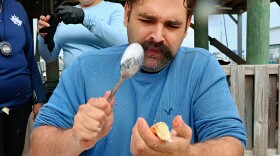A first-of-its-kind football helmet will allow coaches at Gallaudet University, the school for deaf and hard of hearing students in Washington, D.C., to transmit plays to their quarterback via an augmented reality screen.
Players on Gallaudet's football team, which competes in NCAA's Division III, have long faced challenges against teams with hearing athletes, such as an inability to hear referees' whistles that signal the end of a play.
The helmet, which was developed in conjunction with communications giant AT&T, aims to address another of those long-standing problems: Coaches calling plays to the players.
"If a player can't see you, if they're not locked in with eye contact, they're not going to know what I'm saying," Gallaudet head coach Chuck Goldstein said in an explanatory video.
With the new helmet, a Gallaudet coach will use a tablet to select a play that is then transmitted via cell service to a small lens built into the player's helmet. Quarterback Brandon Washington will debut the helmet on Saturday in the Bison's home game against Hilbert College.
"This will help to level the playing field" for deaf and hard of hearing athletes who play in mainstream leagues, Shelby Bean, special teams coordinator and former player for Gallaudet, said in a press release. "As a former player, I am very excited to see this innovative technology change our lives and the game of football itself."
Unlike the NFL, college football generally does not allow the use of helmet-based communication systems. The NCAA has only approved the helmet for use in one game as a trial.
A deaf football team at Gallaudet pioneered perhaps the most iconic sports communication innovation — the huddle. In an 1894 game against another deaf team, Gallaudet's quarterback didn't want to risk his opponent looking in on his American Sign Language conversations with his teammates, so he gathered them around in the tight circle now commonplace in many team sports.
In the 1950s, two inventors persuaded Cleveland Browns coach Paul Brown to try out a radio receiver they had developed to fit inside the quarterback's helmet to transmit plays from the sideline. After four games, its use was banned by the NFL commissioner.
But the NFL relented in 1994. Radio helmets have since become standard in the pros, with telltale green dots marking the helmets of quarterbacks and defensive players who receive the plays via one-way communication from coaches' headsets.
Copyright 2023 NPR. To see more, visit https://www.npr.org.









